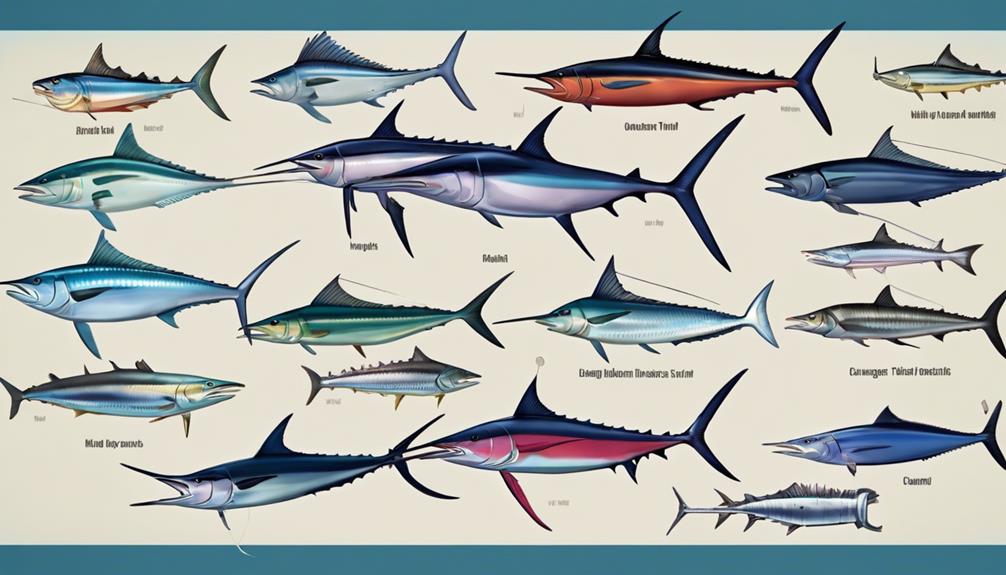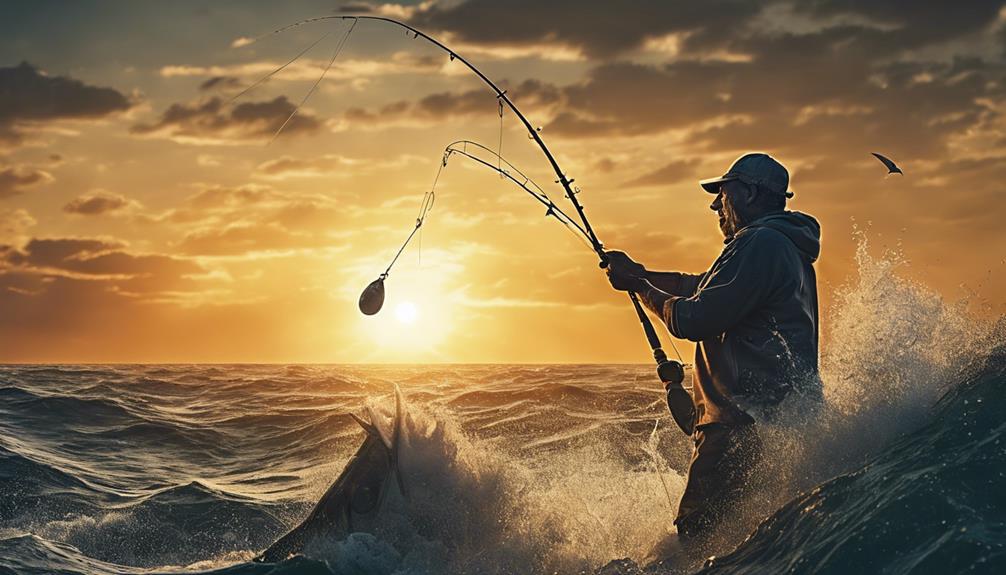If you think deep sea fishing is only for the experienced angler, think again. While shore fishing might seem more convenient, the thrill of battling larger fish in deeper waters is an experience worth considering.
The contrasting environments of the deep sea and the shore offer unique challenges and rewards that cater to different preferences and skill levels. Understanding the differences in location, targeted species, gear requirements, and overall adventure can help you make an informed decision on which fishing experience suits you best.
Location and Accessibility
When deciding between deep sea fishing and shore fishing, consider the location and accessibility based on your preferences and convenience. Proximity plays a crucial role in determining whether you opt for the vastness of the ocean or the tranquility of the shore. If you value convenience, shore fishing may be the ideal choice as you can easily reach nearby spots without the need for a boat. On the other hand, deep sea fishing offers a sense of adventure but requires more planning and time due to the distance from shore.
Shore fishing provides scenic views and opportunities for solitude that may not be as easily attainable when out at sea. The peacefulness of the shore can offer a serene fishing experience, especially if you enjoy being surrounded by nature and away from the hustle and bustle of crowded deep sea fishing locations. Additionally, the accessibility of shore fishing spots allows for spontaneous fishing trips whenever you feel like casting a line.
Consider whether you prefer the convenience and intimacy of shore fishing or the adventure and challenge of deep sea fishing when deciding where to pursue your next fishing excursion. Each option offers its own unique experiences, so weigh the factors of proximity, convenience, scenic views, and solitude to make the best choice for your fishing preferences.
Targeted Fish Species
Considering the types of fish you're targeting is essential when deciding between deep sea fishing and shore fishing. Different species of fish have distinct habitat preferences, seasonal patterns, and migration routes that influence the fishing experience. Here are some key points to keep in mind:
- Fishing Techniques: Deep sea fishing often involves using specialized equipment like heavy rods and reels to target larger pelagic species such as tuna, marlin, and mahi-mahi that dwell in deep waters. Shore fishing, on the other hand, may require lighter tackle and different casting techniques to catch species like snook, redfish, and trout found near the shoreline.
- Habitat Preferences: Understanding the habitat preferences of the fish you're targeting is crucial. Deep sea fish tend to inhabit open ocean waters, while shore fish are commonly found in areas with structures like rocks, reefs, or mangroves. Your choice between deep sea and shore fishing will depend on the specific habitats of the fish you want to catch.
- Seasonal Patterns: Fish species exhibit seasonal behaviors that can impact your fishing success. Some fish migrate to different areas depending on the time of year, while others spawn during specific seasons. Deep sea fishing trips are often planned around these seasonal patterns to maximize the chances of a successful catch.
- Migration Routes: Understanding the migration routes of fish species can help you determine where and when to fish. Deep sea fish may follow specific routes during their migrations, while shore fish may move along coastlines or into estuaries. By studying migration patterns, you can increase your chances of hooking into your desired catch.
Equipment and Gear
To make the most out of your fishing experience, having the right equipment and gear is crucial. When it comes to deep-sea fishing versus shore fishing, the type of tackle options and techniques you use can vary significantly. Deep-sea fishing often requires heavier tackle to handle larger, more powerful fish found in deeper waters, while shore fishing may involve lighter tackle suitable for smaller species closer to the shore.
For deep-sea fishing, consider investing in sturdy rods that can withstand the strong pulls of deep-water fish. Longer rods are beneficial for casting far out into the sea. In contrast, shore fishing may require shorter rods for easier maneuverability in tighter spaces along the shoreline. Your rod selection plays a vital role in your overall fishing success.
Bait choices are also essential. Deep-sea fishing typically involves using live bait or large artificial lures to attract big game fish like marlin or tuna. On the other hand, shore fishing may involve a variety of bait options, including live bait, cut bait, or artificial lures, depending on the targeted species and location.
When considering equipment and gear for your fishing expedition, remember that using the appropriate tackle options, techniques, rod selection, and bait choices can significantly impact your fishing experience and increase your chances of a successful catch.
Cost and Expenses
Costs associated with deep-sea fishing and shore fishing can vary significantly depending on factors such as location, equipment quality, and trip duration. When considering a fishing trip, it's essential to keep budget considerations and financial planning in mind to ensure an enjoyable experience without breaking the bank. Here's a breakdown to help you understand the expenses associated with each type of fishing:
- Deep-Sea Fishing:
- *Boat Charter:* This is often the most significant expense, ranging from $200 to $2000 or more, depending on the size of the boat and duration of the trip.
- *Tackle and Gear:* Quality gear is crucial for deep-sea fishing and can cost between $50 to $200 or more, depending on the equipment needed.
- *Fuel Costs:* Since deep-sea fishing requires traveling to deeper waters, fuel expenses can range from $50 to $500, depending on the distance traveled.
- *Additional Fees:* Some charters may have additional fees for bait, cleaning the catch, or fishing licenses, adding around $20 to $100 to the total cost.
- Shore Fishing:
- *Rod and Reel:* Shore fishing equipment can vary in price, with a good quality rod and reel typically costing between $50 to $150.
- *Tackle Box:* A basic tackle box with lures, hooks, and sinkers can range from $20 to $50, depending on the quality and quantity of items.
- *Bait Costs:* Live bait or artificial lures can cost around $5 to $20 per fishing session.
- *Permits:* Some locations require fishing permits, which can range from $5 to $50, depending on the area and regulations.
Experience and Adventure
When planning a fishing excursion, the thrill of the experience and adventure awaits, offering unique opportunities whether you're out on the open sea or casting your line from the shore. Deep sea fishing caters to thrill-seekers craving an adrenaline rush. The vastness of the ocean, the battle with powerful fish, and the uncertainty of what you might reel in provide an exhilarating experience. The excitement of hooking a big game fish, feeling the tug on your line, and engaging in a challenging fight to bring it aboard is unmatched in the deep waters.
Conversely, shore fishing offers a different kind of adventure. It provides solitude and peacefulness as you stand on the shore, surrounded by the sounds of nature. The tranquility of casting your line into the calm waters, feeling the gentle tug of a fish, and experiencing the serenity of the shoreline can be a therapeutic escape from the hustle and bustle of daily life. Shore fishing allows you to connect with nature, enjoy the simplicity of the activity, and find relaxation in the rhythmic motion of casting and reeling.
Whether you seek the adrenaline rush of deep sea fishing or the peacefulness of shore fishing, both experiences offer a unique adventure that caters to different preferences and desires.
Weather Conditions
In fishing, the weather conditions play a crucial role in determining the success and safety of your outing. Being prepared and aware of safety precautions is essential to ensure a smooth fishing experience, whether you're out at sea or casting your line from the shore. Here are some key points to consider regarding weather conditions:
- Safety Precautions and Preparation:
- Check weather forecasts before heading out to anticipate any sudden changes.
- Pack appropriate gear such as rain jackets, sunscreen, and hats to protect yourself from the elements.
- Ensure your boat, if deep sea fishing, is equipped with necessary safety equipment like life jackets and emergency supplies.
- Communicate your fishing plans with someone onshore in case of emergencies.
- Techniques and Strategies:
- Adjust your fishing techniques based on the weather; for example, use heavier sinkers in windy conditions.
- Look for sheltered spots during rough weather if shore fishing.
- Be mindful of changing tides and currents that can affect fishing patterns.
- Use polarized sunglasses to reduce glare and improve visibility in sunny conditions.
Time and Duration

Considering the impact of weather conditions on your fishing experience, understanding the optimal time and duration for your fishing outing becomes essential. When it comes to deep sea fishing versus shore fishing, the time of day can significantly affect your success. Deep sea fishing often requires heading out early in the morning when the fish are most active near the surface. On the other hand, shore fishing can be more flexible, with many species being active throughout the day, but early morning or evening can still be optimal times for some catches.
Fishing techniques also play a role in determining the best time to fish. Deep sea fishing typically involves trolling or bottom fishing, which can be more productive during certain times of the day based on the movement of the fish. Shore fishing, on the other hand, may involve casting or using bait from a stationary position, allowing for fishing opportunities at various times.
Duration is another factor to consider. Deep sea fishing trips often last several hours to a full day due to the time it takes to reach deep waters and the potential distance from shore. In contrast, shore fishing can be a shorter outing, giving you the flexibility to fish for a couple of hours or even just during high tide when fish are more active near the shore.
Understanding the optimal times and duration for each type of fishing can enhance your overall experience and increase your chances of a successful catch.
Sustainability and Conservation
To ensure the longevity of fish populations and marine ecosystems, it's crucial to prioritize sustainability and conservation practices in both deep sea and shore fishing activities. By adopting eco-friendly practices, you can contribute to preserving the delicate balance of marine ecosystems.
Here are some key ways to promote sustainability and conservation in your fishing endeavors:
- Use of Biodegradable Gear: Opt for biodegradable fishing gear to reduce the impact of lost or discarded equipment on marine life.
- Catch and Release: Practice catch and release techniques to help maintain fish populations and allow species to reproduce effectively.
- Respect Fishing Regulations: Adhere to fishing regulations and quotas to prevent overfishing and ensure the long-term health of fish stocks.
- Support Sustainable Fisheries: Choose to buy fish from sustainable sources to encourage responsible fishing practices and support the well-being of marine ecosystems.
Frequently Asked Questions
What Are Some Common Safety Precautions to Take While Deep Sea Fishing Compared to Shore Fishing?
When deep sea fishing, always prioritize safety. Make sure you have proper safety gear on board and know emergency procedures.
Stay informed about weather conditions and be aware of boat navigation. These precautions are crucial for a successful and safe deep sea fishing trip.
Are There Any Specific Regulations or Permits Required for Deep Sea Fishing That Differ From Shore Fishing?
When heading out for deep sea fishing, remember that there are regulatory differences and permit requirements that may vary from shore fishing. Make sure to check the specific regulations for deep sea fishing in your area, as permits could be necessary.
Stay informed and follow the rules to ensure a safe and enjoyable fishing experience. Keep these requirements in mind to avoid any potential issues while out on the water.
How Does the Experience of Catching Fish Differ Between Deep Sea Fishing and Shore Fishing?
When you're out on the water, fish behavior can vary between deep sea fishing and shore fishing. The catch size might differ too, with larger species often found in deep sea waters.
Keep in mind that fish can be more unpredictable in the deep sea, making the experience more exciting and challenging. Overall, the thrill of reeling in a big catch can be more intense when deep sea fishing compared to shore fishing.
Are There Any Unique Challenges or Obstacles to Overcome While Deep Sea Fishing Compared to Shore Fishing?
When deep sea fishing, you might face unique challenges compared to shore fishing. Equipment differences play a big role since you'll need specialized gear for the deep waters.
Weather conditions can also be more unpredictable out at sea, requiring heightened awareness and preparedness. These challenges can add excitement to your fishing adventure but also demand careful planning and skill to overcome successfully.
How Does the Environmental Impact of Deep Sea Fishing Compare to Shore Fishing in Terms of Sustainability and Conservation Efforts?
When it comes to marine conservation and sustainability, the environmental impact of deep sea fishing is often more significant compared to shore fishing. Deep sea fishing practices can have a larger negative effect on the ecosystem due to the scale of operations and potential bycatch.
To ensure sustainability, it's crucial for fishermen to adopt responsible fishing methods and support conservation efforts to protect marine habitats and species.
Conclusion
Overall, when comparing deep sea fishing to shore fishing, both offer unique experiences and challenges. Deep sea fishing provides access to larger and more diverse fish species, while shore fishing offers convenience and affordability.
The equipment, costs, and time commitment may vary between the two, but both activities offer the opportunity to connect with nature and enjoy the thrill of the catch.
Whether you prefer the open ocean or the peaceful shoreline, fishing is a rewarding and fulfilling pastime for all anglers.



